Oil
- Crude oil reserves in the USA rebounded slightly above 420 million barrels, although the downward trend that began in March 2023 seems intact
- The United States is attempting to alleviate the deficit in the oil market, pointing to the possibility of easing sanctions on Venezuela
- On the other hand, the United States seeks compliance with sanctions and a maximum price of $60 per barrel for Russian oil
- The United States has halted the transport of two tankers, accusing suppliers of violating the maximum price principle for Russian oil
- In August, India purchased Russian oil at $86 per barrel, and in July, at $68 per barrel, indicating the limited effectiveness of the cap on Russian oil
- US production levels are approaching their maximum, slightly above 13 million barrels per day. The EIA (Energy Information Administration) indicates that in 2014, production will average 13.12 million barrels per day, which is 40,000 barrels per day lower than the previous forecast
- The EIA also expects WTI oil to average $90 per barrel next year
- The EIA also anticipates that OPEC+ will continue to limit production next year, with a decrease of 300,000 barrels per day compared to 2023.
- President Biden is traveling to the Middle East to hold talks with the leaders of Israel and Palestine, as well as neighboring states. It is expected that this may lead to a reduction in the intensity of the conflict.
- On the other hand, some traders expect that the expansion of the conflict, particularly involving Iran, could lead to an increase in prices to $150 per barrel. Currently, option prices with a strike price of $150 per barrel for December of this year are very low
- It's also worth noting that Iran alone is not as significant as Russia in the oil market, but the involvement of more Arab states could potentially lead to supply constraints or increased delivery times.
Options do not price in a highly probability of oil prices climbing to as extreme levels as $150 per barrel by the end of this year. Source: Bloomberg Finance LP, XTB
 Oil inventories have increased recently and the difference between this year's and last year's stockpiles shrank from -60k to -40k bpd. Comparative inventories, however, are still pointing to a significant deficit when compared to 5-year average. Inventories should continue to drop until the end of this year. Source: Bloomberg Finance LP, XTB
Oil inventories have increased recently and the difference between this year's and last year's stockpiles shrank from -60k to -40k bpd. Comparative inventories, however, are still pointing to a significant deficit when compared to 5-year average. Inventories should continue to drop until the end of this year. Source: Bloomberg Finance LP, XTB
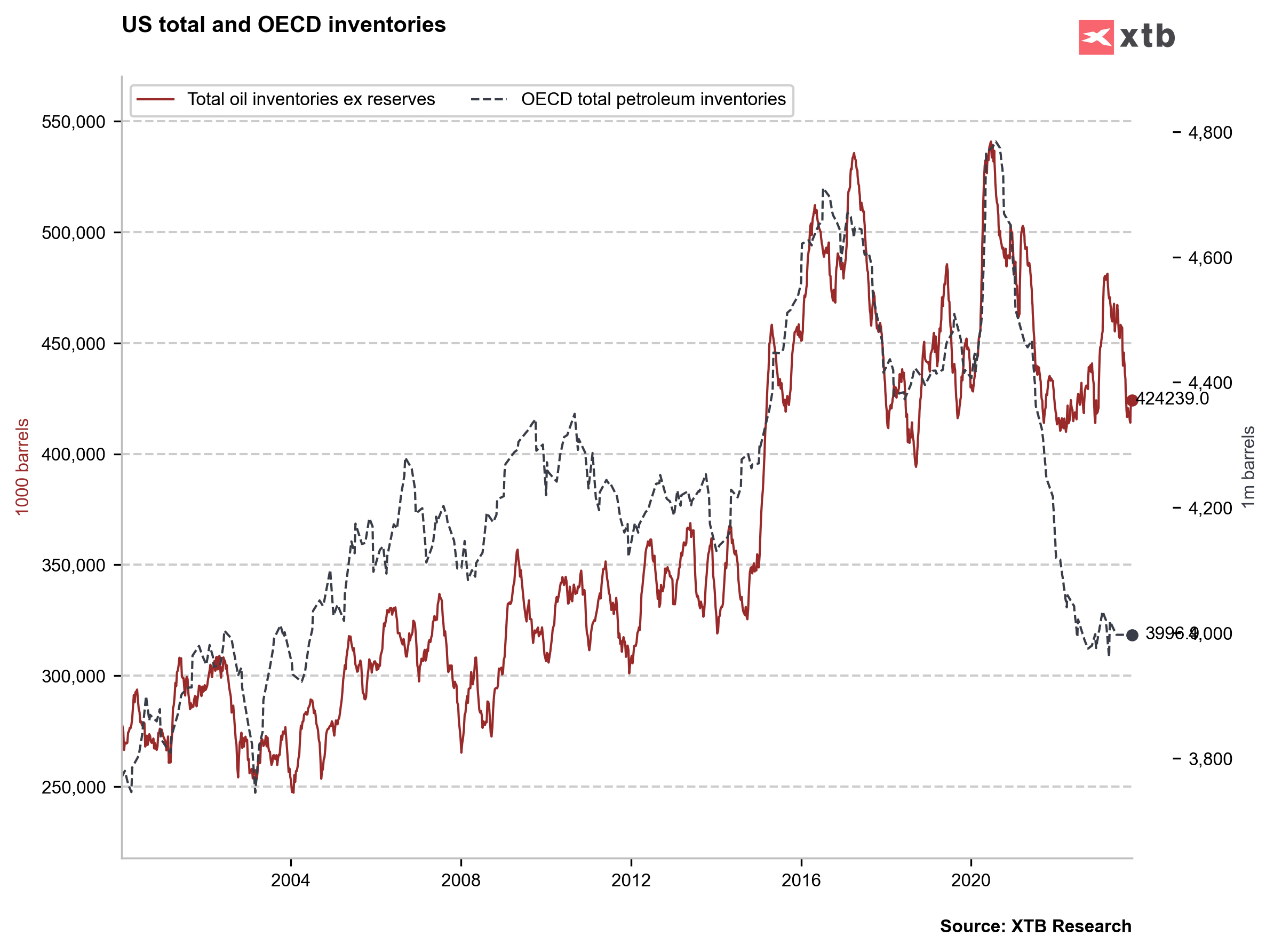
OECD inventories have stabilized recently along with a pick-up in US oil inventories. Source: Bloomberg Finance LP, XTB
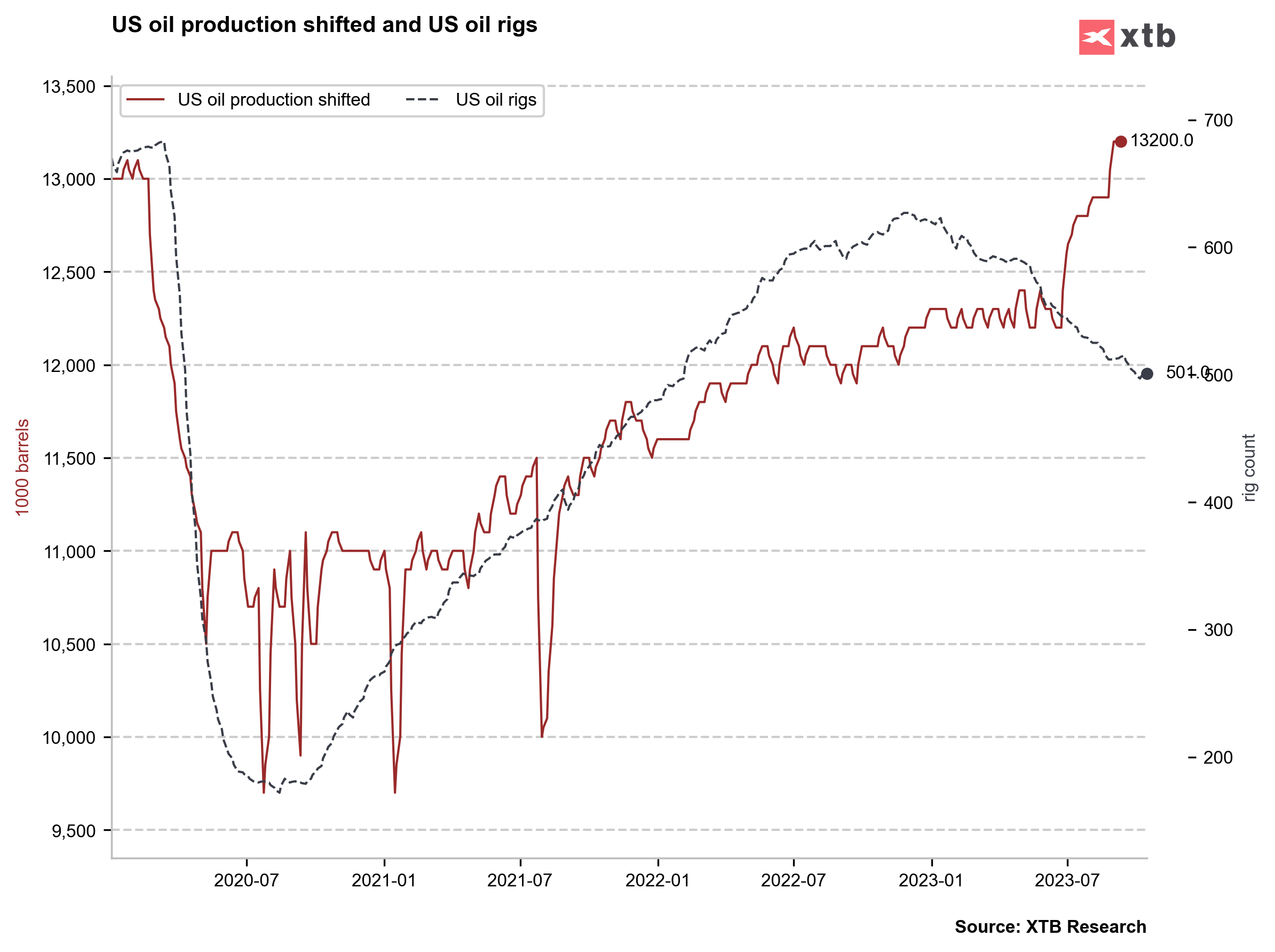
According to weekly estimates, US oil production is exceeding 13 million barrels per day but may be near its peak as number of active oil drilling rigs remains very low. Source: Bloomberg Finance LP, XTB
Gold
- Gold experienced a significant price rebound at the end of the previous week, which could have signaled positioning ahead of uncertainty over the weekend. However, there was no major escalation of the conflict in the Middle East, leading to a slight price pullback from around $1925 per ounce
- The price of the commodity remains in clear divergence with U.S. yields, which have risen following the lack of escalation in the Middle East conflict. Yield increases are occurring despite signals from the U.S. that interest rates may remain unchanged until the end of this year
- Positioning in gold has dropped below levels from the turn of February and March and is at its lowest since October 2022 when there was a notable price rebound
- Currently, in the market, it is suggested that a key indicator of demand for safe assets is the behavior of the Swiss Franc (CHF) since the Japanese Yen (JPY) is linked to uncertainty about monetary policy, and gold is largely tied to U.S. yield behavior. Nevertheless, the direction of the Swiss Franc's behavior may provide signals for gold in the event of an escalation in the conflict
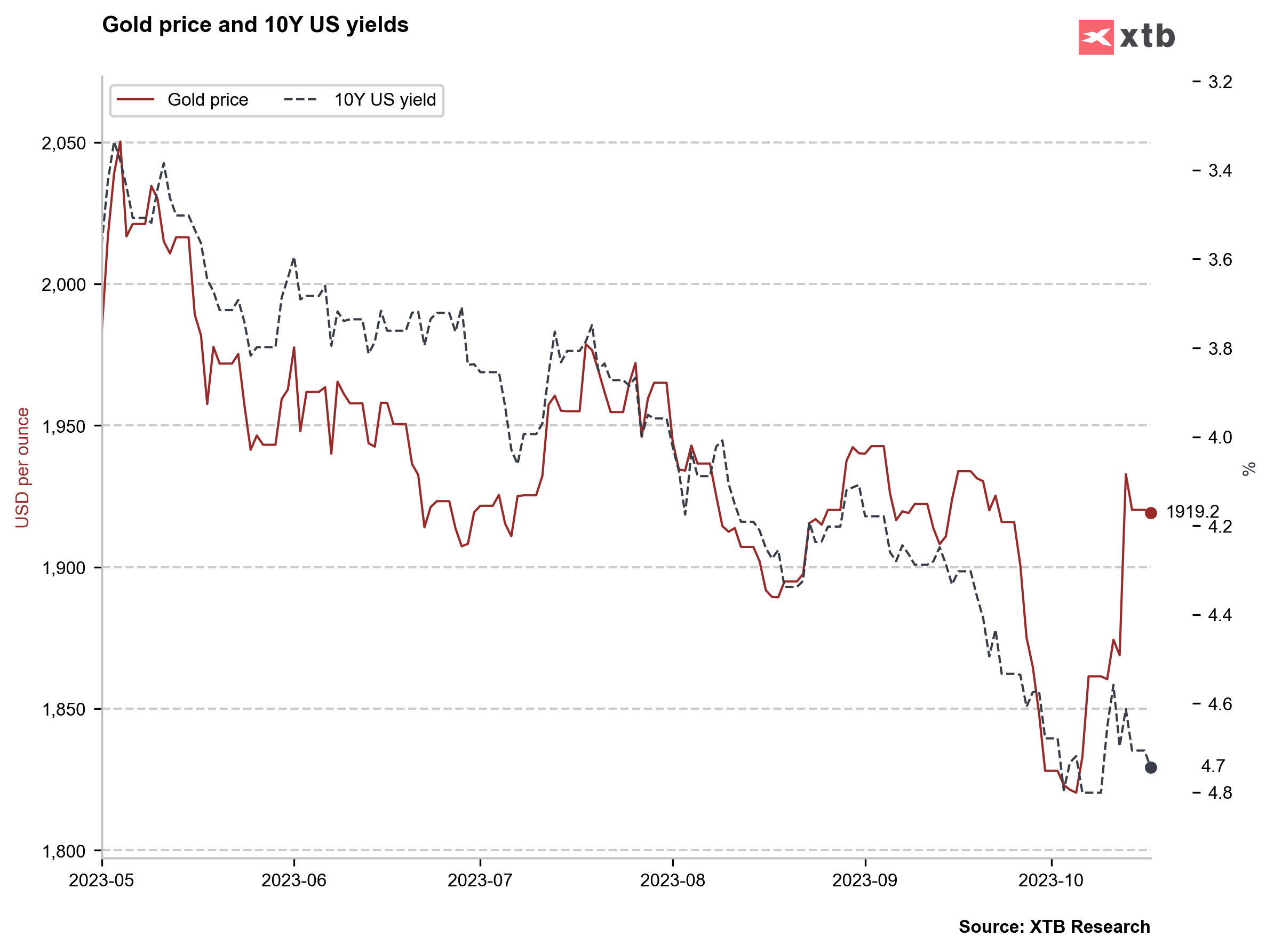
Gold continues to trade in divergence with US yields. Source: Bloomberg Finance LP, XTB
 Gold has rebounded significantly by the end of the previous week but remains in a downtrend started in April this year. A key resistance level to watch should we see a break above $1,925 per ounce can be found in the $1,970 per ounce area, where 61.8% retracement as well as local highs can be found. Source: xStation5
Gold has rebounded significantly by the end of the previous week but remains in a downtrend started in April this year. A key resistance level to watch should we see a break above $1,925 per ounce can be found in the $1,970 per ounce area, where 61.8% retracement as well as local highs can be found. Source: xStation5
Coffee
- Coffee harvests in Brazil are progressing normally. Recent rainfall has alleviated concerns about reduced yields, particularly in the Minas Gerais region, where 30% of Arabica coffee is grown in Brazil
- Robusta harvest in Brazil is also progressing well, with a significant contributing factor being the notable decrease in exports from Vietnam, the world's largest Robusta coffee producer. Robusta coffee exports from Vietnam declined by 8.3% year-on-year in the first 9 months of this year, causing uncertainty about supply availability
- It is expected that coffee harvests in Vietnam will decrease by 7% year-on-year and reach their lowest levels in years
- Interestingly, coffee exports from Brazil are also experiencing a significant decline, as indicated by Cecafe. In September, coffee exports fell by 20% year-on-year to 2.4 million bags, marking the lowest level for that month in six years
- Low exports could be due to a lack of demand or the unprofitability of exports due to a strong currency. However, in September, the Brazilian real weakened
- At this point, the Brazilian real suggests limited potential for price rebounds in the near future
- Further appreciation of the Brazilian real could further constrain coffee exports from Brazil, potentially increasing supply tensions in the world, given the still extremely low global coffee reserves
- Positioning in the coffee market remains very low, and seasonality suggests the potential for price rebounds in November
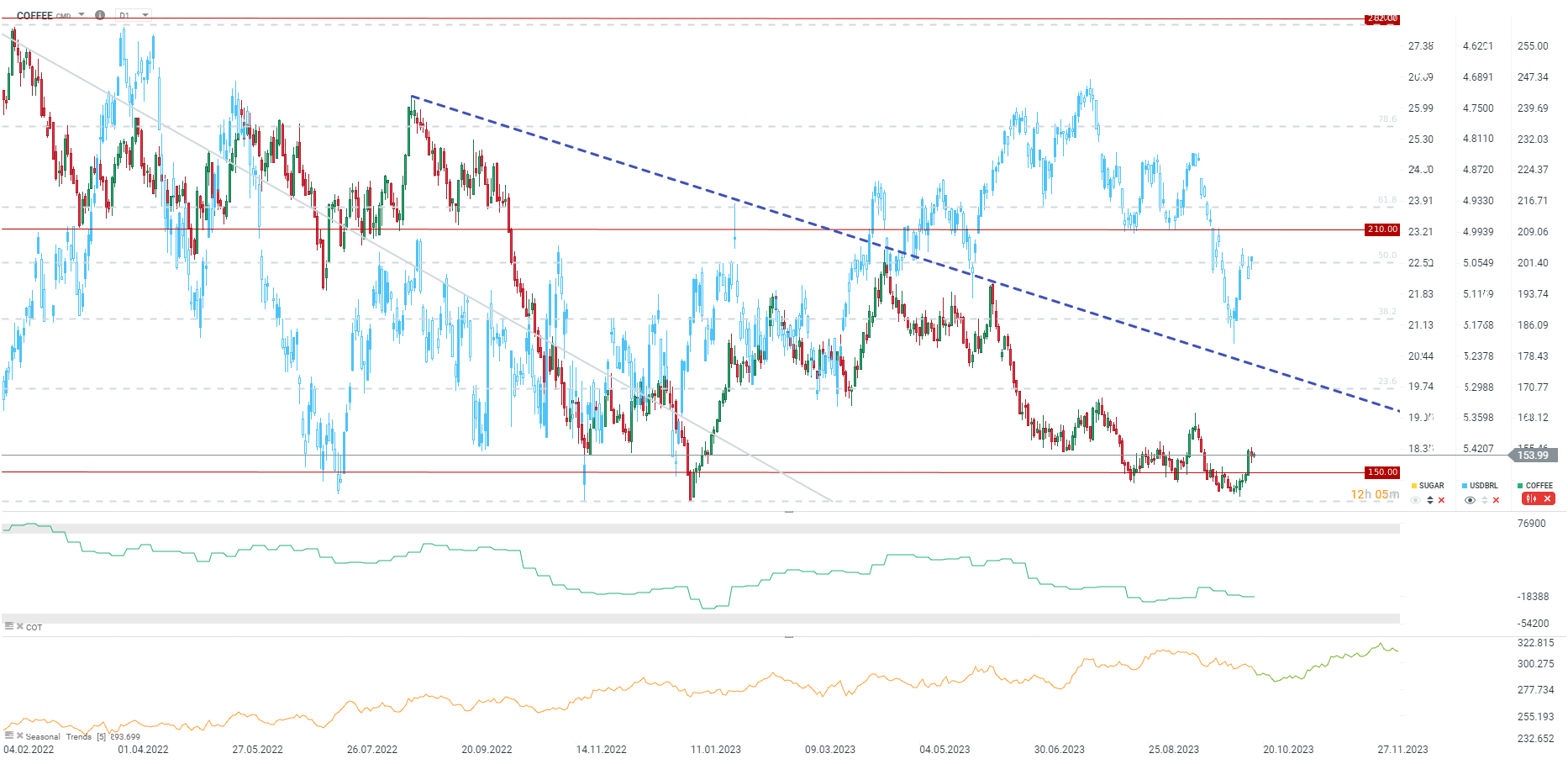
Coffee prices rebounded slightly off the December 2022 lows. A key resistance zone to watch can be found in the 170 cents per pound area and is marked with the 23.6% retracement of the 2022 downward move. Source: xStation5
Copper
- The price of copper is testing the vicinity of $7,900 per ton. The situation in the USD/CNH currency pair is stabilizing
- Copper inventories on global exchanges are starting to rebound from extremely low levels, which may indicate a lack of short-term demand for the metal
- Freeport suggests that at current copper prices, new projects are not profitable (around $8,000 per ton). Prices in the range of $10,800 to $11,000 per ton could trigger the possibility of initiating new investments
- Freeport points to continued demand growth in China, even amid mixed data. The company also highlights the increasing demand for copper cables from data center construction firms
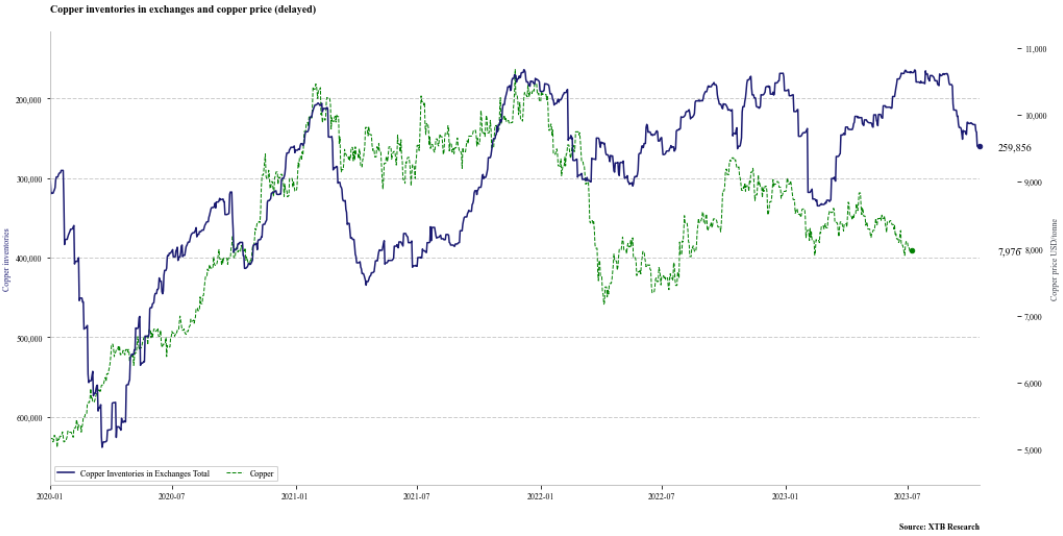
Copper inventories rebounded slightly recently but still remain close to multi-year lows (inverted axis). Source: Bloomberg Finance LP, XTB
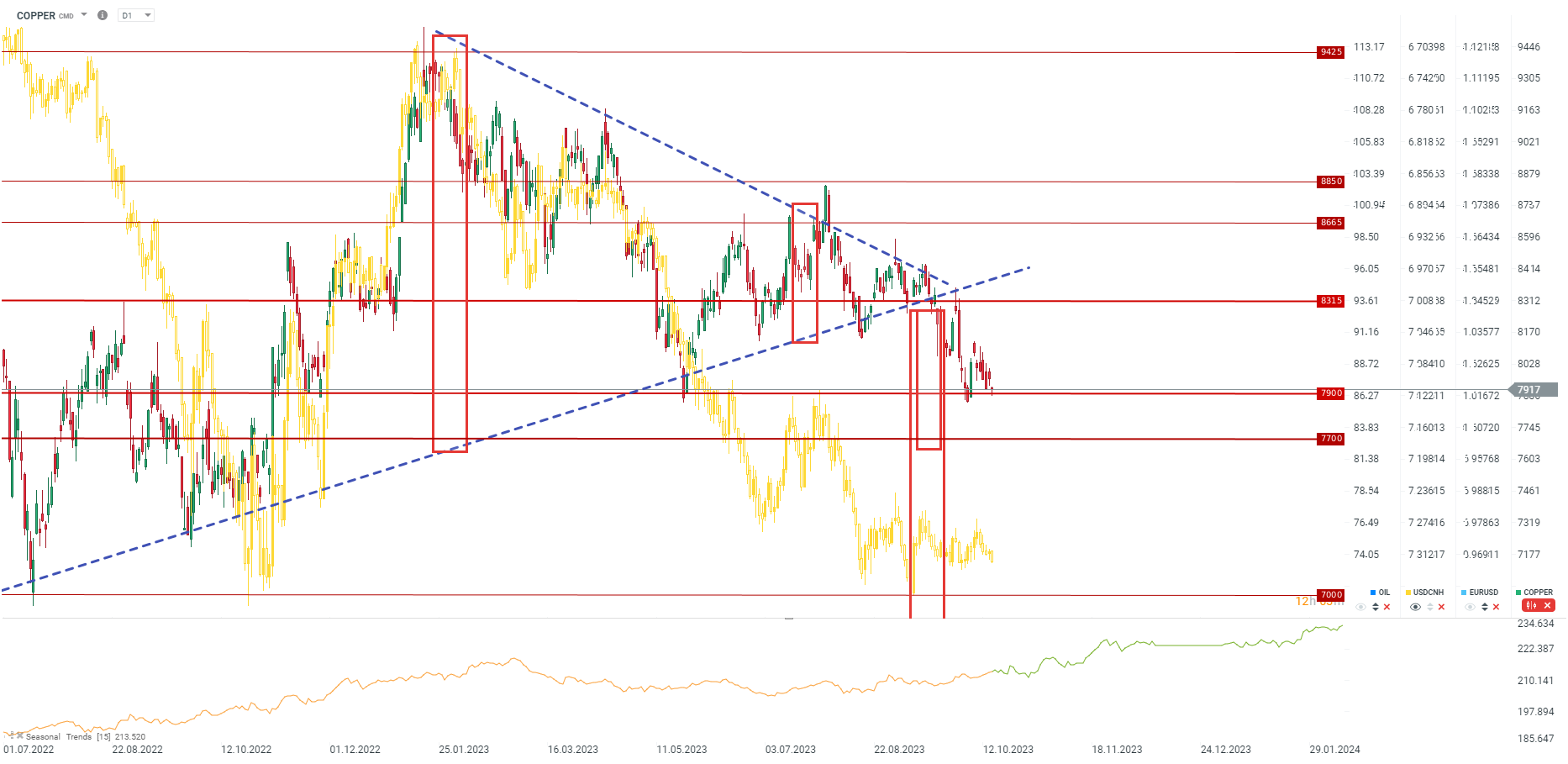
COPPER is trading near $7,900 per tonne amid a sideways trading on USDCNH. An important support zone can be found in the $7,700 per tonne area. Source: xStation5
Will the Fed minutes confirm a pause in further easing? 🔎
Daily summary: Wall Street tries to rebound 📈Amazon and Microsoft under pressure of Rotschild & Co Redburn
Cocoa tries to stabilize after autumn sell-off 📌
Market worries persist, but is the worst of the sell off behind us?
This content has been created by XTB S.A. This service is provided by XTB S.A., with its registered office in Warsaw, at Prosta 67, 00-838 Warsaw, Poland, entered in the register of entrepreneurs of the National Court Register (Krajowy Rejestr Sądowy) conducted by District Court for the Capital City of Warsaw, XII Commercial Division of the National Court Register under KRS number 0000217580, REGON number 015803782 and Tax Identification Number (NIP) 527-24-43-955, with the fully paid up share capital in the amount of PLN 5.869.181,75. XTB S.A. conducts brokerage activities on the basis of the license granted by Polish Securities and Exchange Commission on 8th November 2005 No. DDM-M-4021-57-1/2005 and is supervised by Polish Supervision Authority.


